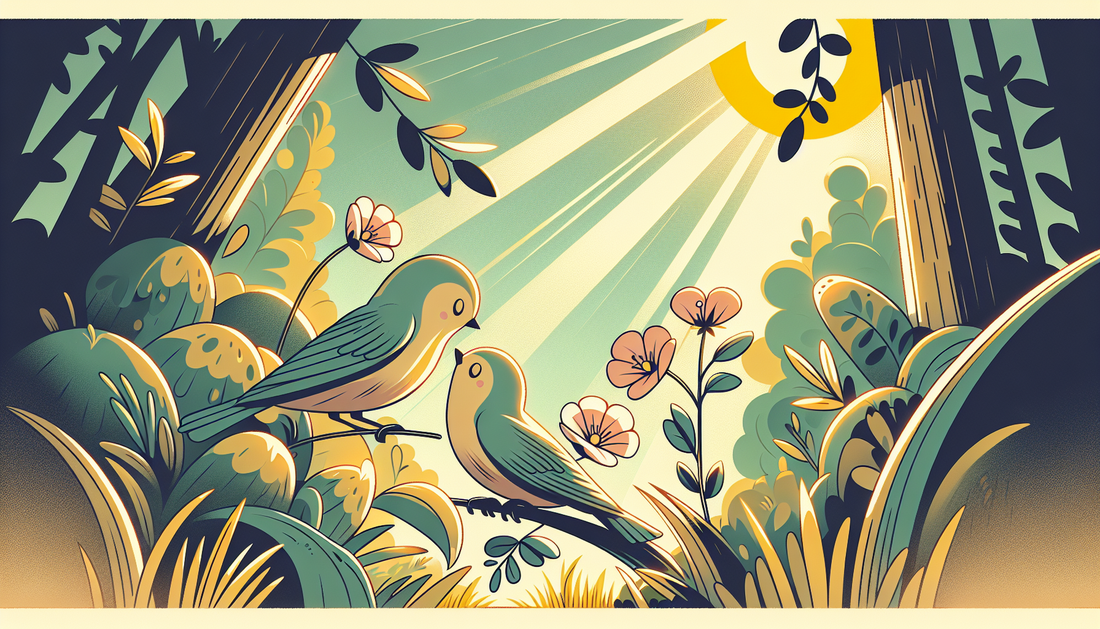
Choosing a bird partner in the garden: experience courtship and the breeding season up close
How do birds actually choose their mates? Especially during the breeding season, the garden looks like a stage full of song, movement and lively activity. But behind the colorful backdrop lies a finely tuned interplay of instinct, mating rituals and communication. For all those who love nature and gardens - whether families, senior citizens or technophiles - it is worth taking a closer look. Because if you understand the mating behavior of garden birds, you can create targeted habitats and contribute to species conservation. In this article, you will learn why mate selection is so important, how courtship and territorial behavior affect pair formation, which camera technology is ideal for bird watching and what you should consider legally. You will gain fascinating insights - right in your own garden and actively protect species at the same time.
Why is mate choice important for birds?

For many garden birds, mate choice is the key to reproductive success. It influences whether the offspring have a good chance of survival and whether a species can survive in the long term.
Females in particular make the choice for many species. They prefer males with conspicuous courtship songs, strong plumage or a secure territory. These characteristics indicate health, experience and territorial strength - for example in chaffinches, blackbirds and wrens.
The willingness to care for their brood also plays a role. Birds invest a lot of energy in rearing and protecting their nests. Only a well-rehearsed pair with a strong genetic predisposition can successfully raise young.
Reproductive behavior varies greatly depending on the species. While tits often stay together with the same partner for several years, sparrows show flexible forms such as seasonal monogamy. In some meadow and wading birds, the female may even choose several males (polyandry) in order to increase genetic diversity.
This diversity shows how strategically birds choose their mates - always with the aim of preserving their species in the best possible way.
How do a pair of birds find each other during the breeding season?
As soon as spring begins, the mating season starts for many native birds. This is a special opportunity for garden enthusiasts to observe the unique behavior of these animals.
Courtship usually begins with singing. Blackbirds, robins and starlings sing loudly and persistently. The song not only serves to mark territory, but also indicates health and vitality. Females use it to recognize the age, experience and condition of their potential partner.
Many species complement their singing with courtship dances, impressive wing beats or spectacular flight maneuvers. The more pronounced the behavior, the greater the chance of arousing the interest of a female.
A good territory also determines mating success. Males choose nesting sites early on and defend them against conspecifics. They lead females to potential breeding sites through targeted "nesting site presentation".
This can be observed particularly well with cavity-nesting birds such as blue tits and great tits. You can even actively support this exciting process by hanging up a nesting box in your garden - and with a bit of luck, the pair will stay near you permanently.
Technical aids for bird watching in the garden
It is possible to observe birds up close without binoculars or hiking. With modern camera technology, your patio or garden becomes an exciting observation point - ideal for families, senior citizens or technophiles.
The right wildlife camera for bird watching
Beginners are best off using weatherproof wildlife cameras with motion detection. They capture images or videos fully automatically as soon as an animal moves. Useful features are:
- WLAN or wireless connection for remote access via smartphone
- At least 12 megapixel resolution and night vision function
- Weatherproof with protection class IP65 or higher
- Silent shutter release for the most interference-free shots possible
Special nest box cameras are available for longer observations. They are installed inside and allow live views of brood care, hatching and feeding - without interfering with the nesting process.
Installation and tips for use in the garden
Place the camera in a quiet, wind-protected location with a direct view of nesting sites or feeding areas. Avoid backlighting from direct sunlight.
Use timer functions to take pictures at specific times of the day (e.g. in the morning). Make sure you are far enough away: 1.5 to 2 meters is ideal to avoid disturbing the animals.
Practical: Many models work with batteries or solar panels - so you are independent of the power grid and can set up the camera flexibly in the garden.
Legal situation: What needs to be considered when protecting birds in Germany?
Birds are protected in Germany all year round. Anyone who observes, feeds or films wild birds must adhere to certain rules - to protect the animals and for their own guidance.
The Federal Nature Conservation Act (§ 44 BNatSchG) prohibits, among other things, the removal, damage or disturbance of nests and breeding sites. Even apparently abandoned nests must not be touched.
Breeding seasons are of particular importance: additional restrictions apply between March and September - especially when cutting back hedges, trees or shrubs.
Tips for a bird-friendly garden in accordance with the law:
- Only carry out hedge maintenance between October and February
- Do not use pesticides or insecticides - they harm food insects
- Install nesting boxes as early as February, far enough away from sitting areas
- Leave piles of leaves and brushwood in the garden - they provide hiding places for insects and small creatures
Current information and protection regulations can also be found at NABU.
Watching pairs of birds in the garden - avoid common mistakes
With patience and consideration, you can gain fascinating insights into the lives of garden birds. But the wrong behavior can lead to disturbances - and in the worst case, to the nest being abandoned.
Avoiding disturbance at nesting sites
Never observe birds at close range. A distance of at least five to ten meters is important to prevent escape situations. Movements or sudden noises should be avoided.
Do not linger permanently near nests or breeding grounds - this also affects the birds' behavior. Screens or telescopic binoculars help you to remain discreet.
Tips for animal-friendly behavior when taking pictures
- No drone flights in the garden during the breeding season - they cause stress
- Do not interfere with nests or nest surroundings - not even with a camera
- Use cameras with motion sensors, do not trigger manually
- Do not use artificial noises or distracting stimuli
Your behavior determines whether birds stay permanently. With care, you can turn your garden into a safe retreat - and experience real moments of nature at the same time.
Practical tips for more bird diversity in your own garden
With simple measures, you can create a bird-friendly environment on your balcony or in your garden - without any major effort. The result: healthy breeding grounds and a variety of species to observe.
Use feeding stations sensibly
Additional feeding is particularly important in winter. Feeders or feed houses with rain protection and stable suspension are suitable. Important: Daily cleaning with hot water to avoid diseases.
Ideal as food:
- Sunflower seeds (peeled & unpeeled)
- Fat blocks with berries or insects
- Dried mealworms for insectivores
- Unroasted, unsalted peanuts for tits and nuthatches
Avoid bread, seasoned or greasy leftovers - these can harm birds.
Design garden structure close to nature
- Use native shrubs such as elder, hazel or hawthorn
- Plant wildflowers - they attract insects
- Provide daily water points with fresh water
- Avoid artificial rock gardens
A well-kept garden rich in structure provides food, shelter and breeding grounds. Over time, this will create a unique natural paradise - right on your doorstep.
Conclusion: If you understand the mating behavior, territory selection and reproduction of native birds, you can provide targeted help - with nesting boxes, technology and the right garden design. Observe carefully, act considerately and design your garden as a habitat. Nature will come to you - without having to travel far away.
Get started now and experience how fascinating the love life of garden birds really is!
FAQ - Frequently asked questions about choosing a partner and observing garden birds
When does the mating season begin for native birds?
The mating season for many species starts as early as February and reaches its peak in March and April. Hanging nesting boxes early is therefore particularly useful.
Which camera is suitable for the balcony?
A compact wildlife camera with radio transmission is ideal. Make sure the housing is weatherproof and the shutter release is silent so as not to disturb visitors to the balcony.
Can I photograph birds' nests in spring?
No, bird nests and breeding birds must not be disturbed. Instead, use cameras with a telephoto lens or automatic shutter release - always from a safe distance.
How can I tell if a territory is occupied?
Loud, frequent singing on raised perches and courtship flights indicate that territories are already occupied. Avoid these areas when gardening or observing.
